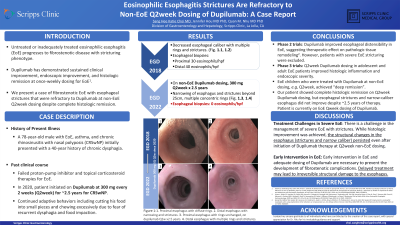Tuesday Poster Session
Category: Esophagus
P3359 - Eosinophilic Esophagitis Strictures Are Refractory to Non-EoE Q2week Dosing of Dupilumab: A Case Report
Tuesday, October 24, 2023
10:30 AM - 4:00 PM PT
Location: Exhibit Hall

Has Audio

Sang Hee K. Choi, MD
Scripps Clinic/Scripps Green Hospital
La Jolla, CA
Presenting Author(s)
Sang Hee K. Choi, MD1, Jennifer Hou, MD, PhD2, Quan M.. Nhu, MD, PhD3
1Scripps Clinic/Scripps Green Hospital, La Jolla, CA; 2Scripps Green Hospital, La Jolla, CA; 3Scripps Clinic & Scripps Research Institute, La Jolla, CA
Introduction: Eosinophilic esophagitis (EoE) is a chronic type 2 (T2) immune-mediated inflammatory disease that progresses to fibrostenotic EoE with stricturing phenotype. Dupilumab blocks T2 inflammation and is FDA-approved for EoE. Dupilumab has demonstrated “deep remission” with sustained clinical improvement, endoscopic improvement, and histologic remission at once-weekly dosing in a phase 3 clinical trial for EoE (Dellon et al, 2022). Herein, we present a case of fibrostenotic EoE with esophageal strictures that were refractory to dupilumab at non-EoE Q2week dosing despite complete histologic remission.
Case Description/Methods: A 78-year-old male with a history of EoE, asthma, and chronic rhinosinusitis with nasal polyposis (CRSwNP) initially presented with a 40-year history of dysphagia. He had failed proton-pump inhibitor and topical corticosteroid therapies for his EoE. EGD in 2018 showed decreased esophageal caliber with multiple rings and strictures. Biopsies showed 30-40 eosinophils/hpf. In 2020, patient was initiated on dupilumab for CRSwNP. On non-EoE dupilumab dosing at 300 mg Q2week for ~2.5 years, our index EGD in late 2022 showed complete histologic remission, i.e., zero eosinophils/hpf. However, EGD showed a narrow-caliber esophagus with multiple rings and strictures that could not be traversed with the adult gastroscope; endoscopic findings were essentially unchanged or worse compared to EGD in 2018. Clinically, patient continued adaptive behaviors including cutting his food into small pieces and chewing excessively prior to ingestion due to fear of recurrent dysphagia and food impaction. Dupilumab was increased to EoE dosing at 300 mg once weekly. Patient is due for a 6-month follow-up EGD soon.
Discussion: In phase 2, dupilumab improved esophageal distensibility in EoE patients (Hirano et al, 2020), suggesting potential therapeutic effect on pathologic tissue remodeling. Severe EoE stricturing patients were excluded. In phase 3, Q2week dupilumab dosing in adolescent and adult EoE patients improved histologic inflammation and endoscopic severity. EoE children who were treated with dupilumab at non-EoE dosing, e.g, Q2week, achieved “deep remission” (Spergel et al, 2022). Our patient showed complete histologic remission on Q2week dupilumab dosing, but esophageal strictures and narrow-caliber esophagus did not improve despite ~2.5 years of therapy. Our case highlights the need for adequate dupilumab dosing for EoE and treatment earlier in the disease to prevent fibrostenotic complications.
Disclosures:
Sang Hee K. Choi, MD1, Jennifer Hou, MD, PhD2, Quan M.. Nhu, MD, PhD3. P3359 - Eosinophilic Esophagitis Strictures Are Refractory to Non-EoE Q2week Dosing of Dupilumab: A Case Report, ACG 2023 Annual Scientific Meeting Abstracts. Vancouver, BC, Canada: American College of Gastroenterology.
1Scripps Clinic/Scripps Green Hospital, La Jolla, CA; 2Scripps Green Hospital, La Jolla, CA; 3Scripps Clinic & Scripps Research Institute, La Jolla, CA
Introduction: Eosinophilic esophagitis (EoE) is a chronic type 2 (T2) immune-mediated inflammatory disease that progresses to fibrostenotic EoE with stricturing phenotype. Dupilumab blocks T2 inflammation and is FDA-approved for EoE. Dupilumab has demonstrated “deep remission” with sustained clinical improvement, endoscopic improvement, and histologic remission at once-weekly dosing in a phase 3 clinical trial for EoE (Dellon et al, 2022). Herein, we present a case of fibrostenotic EoE with esophageal strictures that were refractory to dupilumab at non-EoE Q2week dosing despite complete histologic remission.
Case Description/Methods: A 78-year-old male with a history of EoE, asthma, and chronic rhinosinusitis with nasal polyposis (CRSwNP) initially presented with a 40-year history of dysphagia. He had failed proton-pump inhibitor and topical corticosteroid therapies for his EoE. EGD in 2018 showed decreased esophageal caliber with multiple rings and strictures. Biopsies showed 30-40 eosinophils/hpf. In 2020, patient was initiated on dupilumab for CRSwNP. On non-EoE dupilumab dosing at 300 mg Q2week for ~2.5 years, our index EGD in late 2022 showed complete histologic remission, i.e., zero eosinophils/hpf. However, EGD showed a narrow-caliber esophagus with multiple rings and strictures that could not be traversed with the adult gastroscope; endoscopic findings were essentially unchanged or worse compared to EGD in 2018. Clinically, patient continued adaptive behaviors including cutting his food into small pieces and chewing excessively prior to ingestion due to fear of recurrent dysphagia and food impaction. Dupilumab was increased to EoE dosing at 300 mg once weekly. Patient is due for a 6-month follow-up EGD soon.
Discussion: In phase 2, dupilumab improved esophageal distensibility in EoE patients (Hirano et al, 2020), suggesting potential therapeutic effect on pathologic tissue remodeling. Severe EoE stricturing patients were excluded. In phase 3, Q2week dupilumab dosing in adolescent and adult EoE patients improved histologic inflammation and endoscopic severity. EoE children who were treated with dupilumab at non-EoE dosing, e.g, Q2week, achieved “deep remission” (Spergel et al, 2022). Our patient showed complete histologic remission on Q2week dupilumab dosing, but esophageal strictures and narrow-caliber esophagus did not improve despite ~2.5 years of therapy. Our case highlights the need for adequate dupilumab dosing for EoE and treatment earlier in the disease to prevent fibrostenotic complications.
Disclosures:
Sang Hee Choi indicated no relevant financial relationships.
Jennifer Hou indicated no relevant financial relationships.
Quan Nhu: Regeneron – Advisory Committee/Board Member, Speakers Bureau. Sanofi – Advisory Committee/Board Member, Speakers Bureau. Takeda – Advisory Committee/Board Member.
Sang Hee K. Choi, MD1, Jennifer Hou, MD, PhD2, Quan M.. Nhu, MD, PhD3. P3359 - Eosinophilic Esophagitis Strictures Are Refractory to Non-EoE Q2week Dosing of Dupilumab: A Case Report, ACG 2023 Annual Scientific Meeting Abstracts. Vancouver, BC, Canada: American College of Gastroenterology.

